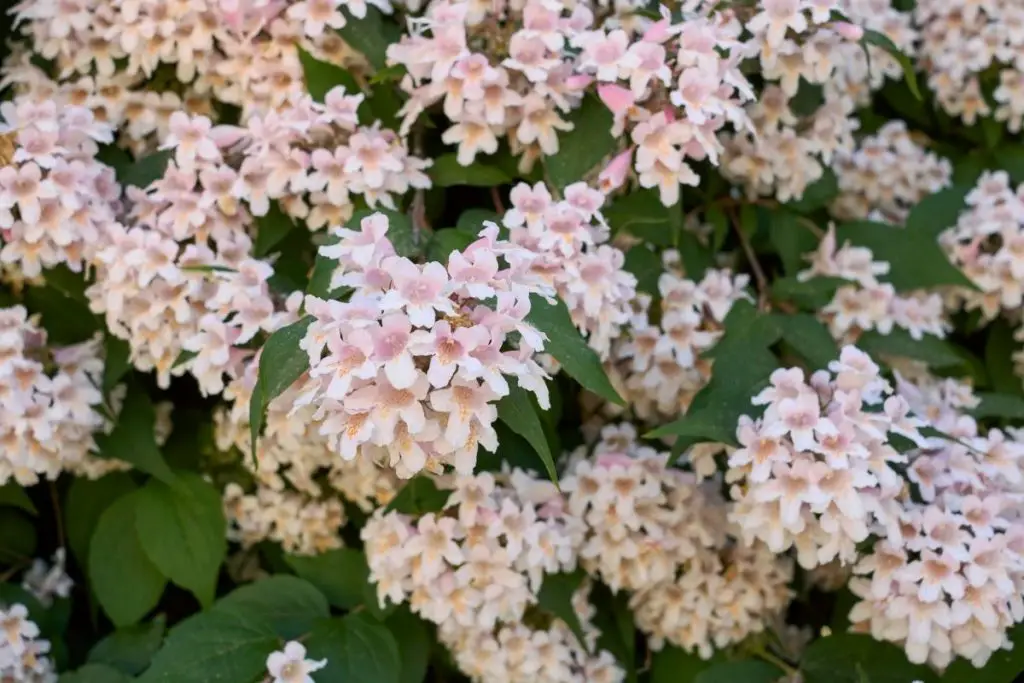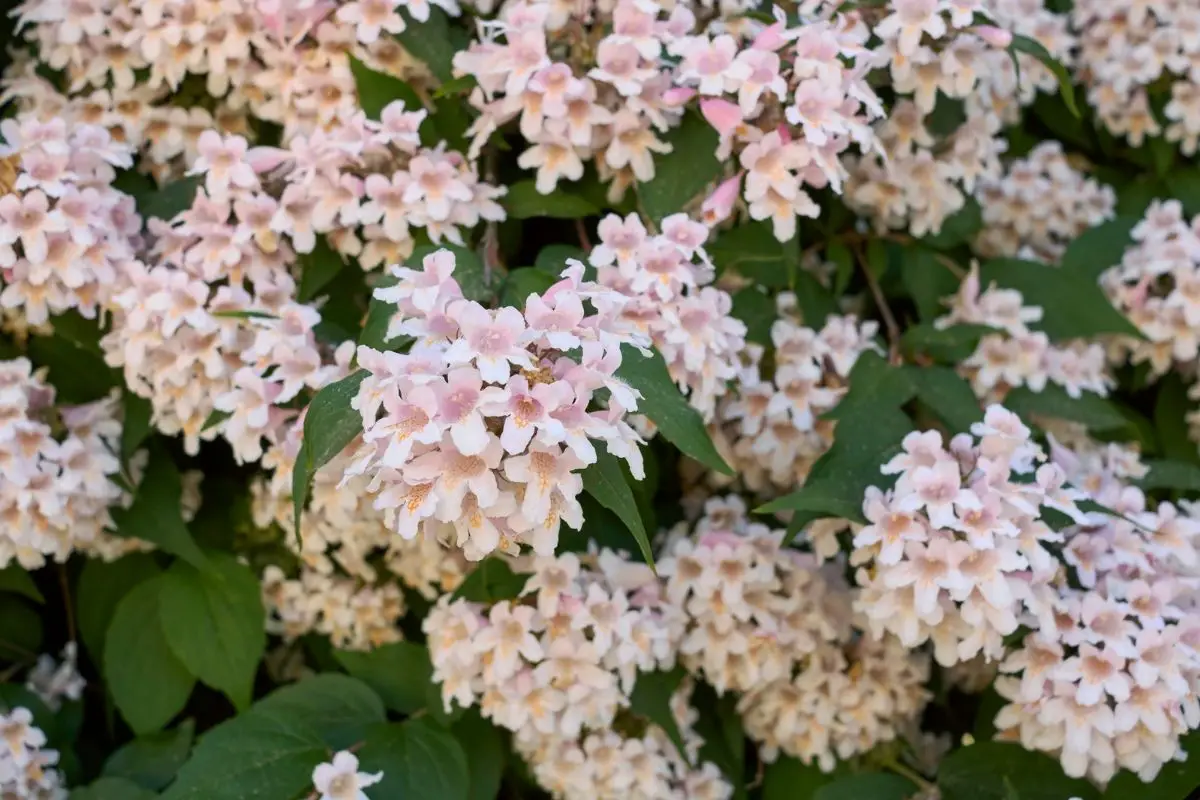Abelia shrubs are easy to grow, and require little maintenance. It is easy to understand why they are a popular landscaper’s choice because they provide color from both flowers and foliage over a long period, and even offer a delicate fragrance. Abelia plants flower over a long season from early summer to fall and attract butterflies and pollinators to the garden.
There are many varieties and sizes of an abelia bush from which to choose. They are a very versatile plant and have many uses in the garden. You can grow them individually, in containers or in a line to form a hedging plant.
All commonly grown abelias are perennial shrubs that can be evergreen, semi-evergreen or deciduous depending on the warmth or coolness of their growing environment. They are native to eastern Asia and to southern America.
This plant is not known to be toxic to humans or pets, although people with an allergy to honeysuckle may experience an allergic reaction if exposed to abelia.
History
Abelia chinensis was imported to the UK during the middle of the 19th Century. Formerly abelia was recognized as a plant species in its own right, but in 2013 it was reclassified into the Linnaea genus.
Plant Facts
| Scientific name | Linnaea x grandifloraAbelia x grandifloraLinnaea x chinensisLinnaea x uniflora |
| Common names | Glossy abelia |
| Genus | Linnaea |
| Family | Caprifoliaceae |
| Height | Up to 10 feet |
| Width | Up to 10 feet |
| USDA Plant Hardiness Zone | 6 to 9 |
| Native to | Eastern Asia and southern America |
| Blooming season | Summer to fall |
| Flower colors | Shades of pink and white |
| Plant specific features | Fragrant blooms, foliage interest, can be grown in pots or in the ground |
How to Plant and Grow

Where to plant
To obtain the best from your abelia plant, you need to choose its location with care. It can be grown in sun or partial shade, but if you want optimal results, try to find somewhere that is protected from the wind and gets about six hours of sunshine. The increased sun will result in better foliage color.
When to Plant
As with many shrubs, fall is the best time to plant your abelias. Planting in fall enables the plant to become established and develop its roots before it enters a period of winter dormancy. A healthy and well-established root system will give the plant the ability to absorb essential nutrients and moisture from the ground to enable it to flower well once it bursts into life the following spring.
If it isn’t possible to plant in the fall, then the early spring is a viable alternative. Once again, there is time for the plant to grow before it starts to form flower buds.
Planting should take place once the danger of frosts has passed. However, spring planting can be risky if there are late frosts or cold winds. Harsh weather conditions can stress the plant, stunt its growth and reduce subsequent flowering. So be prepared to provide a bit of protection around a spring-planted abelia if inclement weather is predicted.
How to Plant
An abelia is not too fussy and is very easy to plant.
You just need to dig holes that are twice as wide and twice as deep as the root ball. The hole needs to be wider than the roots to help them to grow when first put into the soil. Backfill the hole around the roots of the plant using soil from the planting hole mixed with soft soil or compost.
When planted, the plant should sit just a little higher than the soil. This will aid drainage from around the plant.
Planting in Containers
An abelia is a popular garden plant, not least because it provides attractive flowers, is often evergreen and doesn’t require a great deal of work. If you have a small garden, you may decide to grow the shrub in a pot or container.
As long as the pot is sufficiently large, an abelia will do well when it is container grown. It can be placed in a sunny position, moved around if necessary and protected during periods of intense cold. To choose the size of your pot, aim for one that is around 8 inches bigger than the width of the root ball of the abelia. This will give the shrub room to grow for about two years, before it needs to be repotted into a larger container.
The one thing to remember is, as with all container-grown plants, that the soil will dry out quicker than in open ground. This means that you will have to water the plant more regularly, but be wary of overwatering. You don’t want your abelia to sit in soggy soil.
Plastic pots dry out quicker than those made from natural materials. They are also lighter and more susceptible to blowing over in windy weather.
Make sure that the pot you have selected has good drainage. You can add some crocks and/or porous fabric to the pot to increase the efficiency of the drainage before placing some growing medium in the base. After carefully removing the abelia from its pot, place it in the newly prepared container and ensure it sits straight and not too deep. You can then backfill around the root ball and water thoroughly. In early spring, you can apply slow release fertilizer which will give you the best results.

Care and Maintenance
Here are some important care tips for your abelias:
Soil
The basis for good growing conditions lies in the growing medium in which your plant is going to grow. Ideally, the soil should be between 5.5pH and 7pH. Most garden soils fall into this range, but if your soil is particularly heavy or clay, you may need to add some sand or good quality topsoil. If your soil is very sandy, then you should add in some compost or other organic matter in order to condition the soil before planting.
Water
Well-drained soil is essential for the abelia. Like many other shrubs, an abelia bush will not thrive if it is left to sit in soggy or waterlogged soil. It will be prone to disease and rot.
After planting, soak the soil around the base of the abelia plant well. A good watering will help to settle the soil around the root ball and encourage new growth. However, if you are planting during the winter, the plant will not need so much water.
During the first flowering season, abelias should be kept well watered. The best method is to provide a plentiful supply of water and then let the plant dry out in between watering. This is a more economical use of water and more beneficial to the plant.
In subsequent years, the abelia will have become a tough plant that is resistant to drought. It will only be necessary to water the shrub if there is an extended hot, dry spell.
Fertilizer
Although it isn’t essential to feed your abelia, by doing so you will encourage a better display of foliage and flowers. It is important to feed the plant early in the growing season with a slow-release fertilizer designed for shrubs and trees.
Sunlight
An abelia will grow in sun or partial shade. But, for the best display of color, the plant needs to receive a good amount of sunshine. If you can find a site where the shrub will have six hours of sunshine, this is ideal.
Pruning
As already said, this is a plant that doesn’t require much intervention to do well. However, you can improve the shape of your abelia, or keep it to an appropriate size by pruning. You can remove untidy or straggly growth, reduce its spread or height, or give it a formal look.
The best time to prune your abelia is late winter or early spring before new growth forms. Because abelia flowers on new wood, if you prune after it has started to sprout, you will lose flowers.
Pests and disease
There are no major problems with pests. If aphids cause a cosmetic problem, they can often be eliminated by a quick jet of water from a powerful hose.
Fungal disease or root rot is more likely to be a problem if you leave your abelia lying in waterlogged soil for extended periods of time.
Temperature and Humidity
Glossy abelia, (A. grandiflora) is hardy from USDA zones 5 to 9. The warmer the region, the larger the plant will become. In zones 5 or 6, the stems may die back during the winter and an abelia will be grown as a deciduous plant.
Abelia likes to be in well-drained soil and to be allowed to dry out between watering. Humid conditions are not ideal, and the plant is prone to root rot and other fungal diseases if left in waterlogged soil.
Propagating Abelia
The most usual way to propagate this shrub is to take soft stem cuttings during the summer. Only take cuttings from healthy stems. It is better to take cuttings during the morning, when the stems hold more moisture.
Alternatively, it is possible to take hardwood cuttings during the winter when the plant is dormant. Only take these cuttings from mature growth (at least a year old) and dip them in hormone rooting powder before planting in soil or potting compost. Hardwood cuttings tend to be less successful than soft stem cuttings taken during the summer.
It is not possible to propagate hybrid abelias from seeds, as they have been developed to have sterile flowers.
Abelia shrubs can be transplanted fairly successfully in early spring or fall, providing you take care to keep the root ball intact during the move. The best way to achieve this is to wrap the root after you have dug it up. This will serve to protect it and to keep some original soil around the plant.
Other Uses for Abelia
Abelia is a versatile plant to grow and can be adapted for many purposes. This makes the shrub an attractive and popular choice for landscapers. It can fit in well in a mixed herbaceous border, or can be used as an individual, specimen plant. Sometimes, abelia is used as a hedging plant or as a shrub to control soil erosion on banks and slopes.
In environmental gardens, the abelia is a good choice as it will attract bees and butterflies.
Types of Abelia You Can Grow
There are different abelias available, including these popular and beautiful varieties:
- Abelia x grandiflora (glossy abelia) is a hybrid of two Chinese species and the most commonly grown abelia and will grow to around 8 feet.
- Abelia “Kaleidoscope” is a popular, dwarf, evergreen abelia that is often used for ground cover as it won’t grow more than 3 feet high.
- Abelia “Edward Goucher” is a compact, semi-evergreen variety that will grow up to 5 feet. This is a widely grown abelia with interesting foliage and pretty, long-lasting flowers.
- Abelia mosanensis (fragrant abelia) is the most fragrant of all abelias, and it will even grow in USDA zone 4. This shrub has pretty pale pink flowers in the spring and fills the air with its delicate fragrance of jasmine.
Conclusion
It is no wonder that the abelia is a popular choice for gardeners. There is a good choice of sizes available, so it will fit into any space. Once established, it is virtually maintenance-free. And, as well as having attractive foliage, it will produce fragrant flowers for an exceptionally long time and attract pollinators to your garden.
See more: Abelia Companion Plants
~ image source: depositphotos/simonapavan

